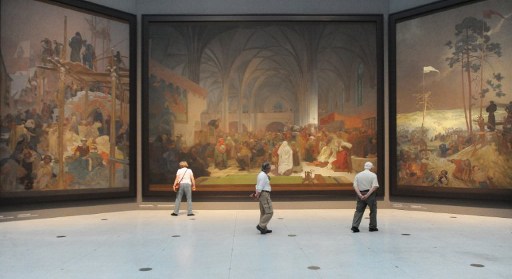
Visitors look at paintings of the “Slav Epic”, a cycle of 20 allegories tracing the history of the Slavic people and inspired in part by mythology, by Art Nouveau Czech artist Alfons Mucha, at the National Gallery in Prague. Photo from AFP.
PRAGUE, Czech Republic — The giant Slav Epic series by Art Nouveau icon Alfons Mucha is caught in a legal tug-of-war between the city of Prague and the Czech painter’s grandson, triggered by plans to send the work on tour to Japan.
Though the late artist seduced early 20th century Paris with his floral posters of actress Sarah Bernhardt, Mucha considered his masterpiece to be the 20 huge paintings that recount the history of the Slavic people.
But his grandson, John Mucha, has sued the city, questioning Prague’s ownership of the allegoric cycle inspired in part by mythology, with a local court scheduled to take up the case in January.
The legal wrangling puts a question mark on plans to display the canvases — ranging between 20 and 50 square meters (215 and 540 square feet) — in Japan next year.
“The Japanese are great admirers of Alfons Mucha,” says Magdalena Jurikova, director of the Prague City Gallery in charge of the work.
“One of the Slav Epic canvases was already on display in Japan and the Japanese side has always sought to welcome the work as a whole.”
The National Art Centre in Tokyo wants to exhibit the collection from March to June to coincide with the Year of Czech Culture, marking the 60th anniversary of renewed diplomatic ties between Japan and the Czech Republic.
But John Mucha has cited concerns raised by certain conservators that the transportation as well as the different climate in Asia poses risks of damaging the artwork.
Moving the collection to Asia would be “a risky and irresponsible business,” says Karel Stretti, head of the restoration department at the Academy of Fine Arts in Prague.
The Prague City Gallery begs to differ.
“I have rolled, installed and uninstalled these canvases in different galleries across the world and the Czech Republic and we never had to restore them after travel,” says curator Tomas Berger, who will accompany the work to Japan.
In addition, the canvases will be flown in air-conditioned boxes and for security reasons put on three different planes, the gallery director says.
– Who’s the owner? –
Jurikova also says she does not believe the Tokyo exhibition is in jeopardy because of the court case.
According to a 1913 contract, the work was commissioned by an American Slavophile. Charles Crane, with the intention to donate it to Prague.
John Mucha, who lives in London, believes the contract says Crane donated the work on the condition that the city offers a decent building for it.
The versatile artist, who designed furniture, jewelry, stained glass, theatre sets, postage stamps and bank notes, even left in his files architectural sketches for the building he desired.
However, a century later the paintings have yet to find a permanent home and are temporarily on display at the national gallery in Prague’s Trade Fair Palace.
“Prague has not met this clearly formulated condition to the present day,” the grandson’s lawyer Frantisek Vyskocil said in a letter to city hall.
He said the paintings should therefore return to the family — a claim the city disputes.
The contract “clearly says that the Slav Epic belongs to the city and the conditions do not include the construction of a new building”, said Prague councilor in charge of culture, Jan Wolf.
Turbulent history
The row adds another chapter to the work’s turbulent history.
In the 1930s and 40s, the canvases were placed in a depository and then hidden under a pile of coal from the Nazis, who considered Mucha a freemason and Jewish sympathizer.
The post-war communist regime in turn denounced Mucha, who died in 1939, as a decadent bourgeois.
It was only in the 1960s that the collection was taken out of obscurity and put on display at the Moravsky Krumlov castle in the Czech countryside.
In 2012, the paintings were moved to Prague as castle conditions deteriorated.
John Mucha would like the work returned to Moravsky Krumlov, which lies only a dozen kilometers from Ivancice, the town where his grandfather was born.
He believes the castle could host a Mucha Centre.
But Jurikova says the castle is “in a sorry state”, adding that because of space issues the “the work can’t be displayed as a whole there” but would need to be spread across floors.
She believes the only solution is to build an ultra modern pavilion for it.
“We do have the money and we are willing to do that,” adds city councilor Wolf.